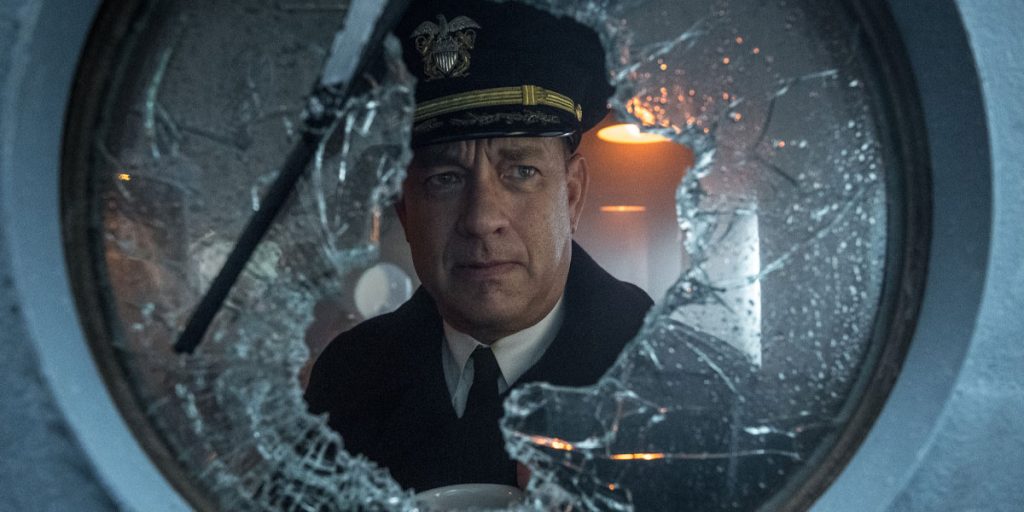Greyhound is an effective detail-obsessed war film carried by a strong central performance from Tom Hanks.
Never have I seen a war movie quite so obsessed with the minutiae of waging war. Greyhound derives tension not from whether our heroes’ depth charges will impact the enemy submarines, but rather from the process of calculating how to find the submarines at all. Each new sonar ping results in a crewmember with a compass running lightning fast trigonometric equations to determine location. Each location is relayed from man-to-man to the bridge and each heading is adjusted in turn and with precision. I suspect, for someone who is not a World War II nerd, the sensation might be a bit overwhelming. I was enthralled.
Director Aaron Schneider (Get Low) smartly paces the film. The entire movie runs only about 83 minutes exclusive of credits – it is lean and to the point which helps maintain the tension. The film’s first act at sea is made up almost entirely of the titular Greyhound’s efforts to hunt one Nazi U-Boat. It is a tense, exciting bit of direction and a wonderful genre subversion. Most submarine movies tell the story from underwater; Schneider flips the usual tension back to the terror of unseen torpedoes just beneath the stirring surface. When the presence of numerous other German submarines is soon revealed, Schneider ratchets up a tone reminiscent of a horror film.
Aided by a wonderfully expressive score from Blake Neely, a disciple of Hans Zimmer, the U-Boats are accompanied by orchestral beats that sound almost like demonic orcas unleashed from the gates of hell. It Is to Schneider’s credit that moments of the film have a real sense of unpredictability: in our hearts we know Tom Hanks did not write and star in a movie where an entire convoy of Allied ships are brutally murdered by Nazi submarines, but his ability to generate tension over the outcome is a feat.

The film works in large part because of Tom Hanks (Saving Private Ryan)’s lead performance. On screen for the overwhelming majority of the film, Hanks is tasked with applying his fundamental everyman decency to a role that is right in his wheelhouse. His Captain Krause – on his first command across a perilous North Atlantic crossing – is made up of a fundamental sense of decency. The character varies from the World War II classic archetype in a few ways. He is not that loud, ornery, supremely confident leader of man we have been conditioned to expect in our war movies. Rather, this Captain has doubts. There is no question he is smart and qualified, but it is abundantly clear he is on his first command. At times, he bungles a crewman’s name or forgets to change his gear at the right time. Schneider ably captures the tension this creates in the crew from the glances of his men: frequently the camera will hold a glance for just a few beats too long. It serves to effectively give the impression of all eyes, all hope, and all doubt falling upon Hanks.
Hanks’ Captain Krause is the sort of man who quickly prays grace even before a cup of coffee, and the sort who succinctly corrects a crewman’s quip about “50 dead Krauts” to “50 lost souls;” it is the rare earnest display of religiosity and faith in a major Hollywood film these days. The performance is not out of sorts with so many of his other heroic everyman roles, but there is a comfort in seeing our modern Jimmy Stewart play a good man tasked with stopping an onslaught of Nazis in these trying times.
The supporting cast is all credible, but left with little to do. Stephen Graham, a frenetic burst of energy in last year’s The Irishman, is effective as Krause’s second-in-command and targeting expert. He carries himself with the sort of swagger that instantly establishes the deep respect the crew would have for the men. The character serves as the only outlet for Hanks’ internal tension, a subtle sounding board for command decisions, and the relationship works. Elisabeth Shue (Leaving Las Vegas) is fine in the film’s few brief flashbacks to Hanks’ life before deployment. Rob Morgan (Bull) deserves more than his modest role as the ship’s cook will allow. Everyone else is basically a fungible crewmember with no real character development, just earnest efforts to do their duty.
Greyhound may serve as a referendum for what you want out of a film. If you are content with superb, detail-oriented craftsmanship, exciting scenes of war, and an excellent lead performance, you are in for a treat. If you worry you may struggle to engage without a genuine focus on character growth and change, Greyhound is not going to work for you. It is a simple story, told very well, and for me that was more than enough. And these days it sure is nice to see Tom Hanks taking down some Nazis.
Greyhound is now available to watch on AppleTV+.

